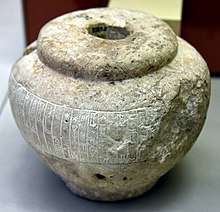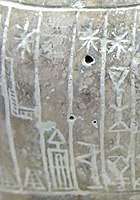La-erabum
La-erabum or Lasirab (𒆷𒂍𒊏𒀊 la-é-ra-ab also read la-a3-ra-ab, formerly read la-si-ra-ab,[2] fl. circa 2150 BCE) was the 12th Gutian ruler of the Gutian Dynasty of Sumer.[3]
| La-erabum or Lasirab 𒆷𒂍𒊏𒀊 | |
|---|---|
| King of Sumer | |
 Mace dedicated to a deity by La-erabum ("Lasirab"), king of Gutium. British Museum, BM 90852[1] | |
| Reign | fl. circa 2150 BCE |
| Predecessor | Apilkin |
| Successor | Irarum |
| Gutian language | La-erabum or Lasirab |
| House | Gutian Dynasty of Sumer |

Sumerian King List
La-erabum is mentioned in the "Sumerian King List" (SKL). According to the SKL: La-erabum was the successor of Apilkin. Irarum then succeeded La-erabum, also according to the SKL.[4]
Votive macehead
A votive macehead with his name is located in the British Museum (BM 90852). It was excavated in ancient Sippar.[5] The macehead inscription reads:
𒆷𒂍𒊏𒀊 / 𒁕𒈝 / 𒈗 / 𒄖𒋾𒅎 / [...] / 𒅁𒉌𒈠 / 𒀀𒈬𒊒 / 𒊭𒁾 / 𒋜𒀀 / 𒌋𒊓𒍝𒆪𒉌 / 𒅇𒋳𒋢 / 𒄿𒊓𒋫𒊒 / 𒀭𒄖𒋾𒅎 / 𒀭𒈹 / 𒅆𒂍 / 𒀭𒂗𒍪 / 𒁼𒋢 / 𒇷𒍪𒄩 / 𒅇 / 𒊺𒆰𒍪 / 𒇷𒅋𒄖𒁕 / 𒅇 / 𒆜𒆠[x]𒋢 / 𒀀𒄿𒋛𒅕
la-'a3-ra-ab / da-[num2] / lugal / gu-ti-im / (n lines broken) [...] / ib-[ni]-ma / a mu-ru / sha dub / su4-a / u-sa-sa3-ku-ni / u3 shum-su / i-sa-ta-ru / {d}gu-ti-im / {d}inanna / u3 / {d}suen / suhush-su / li-su2-ha / u3 / she-numun-su2 / li-il-qu3-ta2 / u3 / kaskal{ki}-x-su2 / a i-si-ir
"Lasirab, the mighty King of Guti, ...[6 colums damaged]... has made and presented this. Whoever removes this inscribed stone, and writes the mention of his name thereupon, his foundation may Guti (or, "the Gods of Gutium"), Nina and Sin tear up and exterminate his seed, and may whatsoever he undertakes not prosper"
.jpg) "La-eraab, great King of Gutiim" (𒆷𒂍𒊏𒀊 𒁕𒈝 𒈗 𒄖𒋾𒅎 la-e-ra-ab da-num lugal gutiim). The name is quite damaged, and was initially read "Lasiraab".[12]
"La-eraab, great King of Gutiim" (𒆷𒂍𒊏𒀊 𒁕𒈝 𒈗 𒄖𒋾𒅎 la-e-ra-ab da-num lugal gutiim). The name is quite damaged, and was initially read "Lasiraab".[12]
| Preceded by Apilkin |
Gutian Dynasty fl. circa 2150 BCE |
Succeeded by Irarum |
References
- "votive offering / mace". British Museum.
- The Sumerian Kings List (PDF). p. 119, note 305.
- The Sumerian King List, The Electronic Text Corpus of Sumerian Literature, Oxford University
- The Sumerian King List, The Electronic Text Corpus of Sumerian Literature, Oxford University
- "votive offering / mace". British Museum.
- Rogers, Robert William (2015). History of Babylonia and Assyria. Cambridge University Press. p. 360. ISBN 978-1-108-08307-2.
- "votive offering / mace". British Museum.
- Thureau-Dangin, F. (François) (1905). Les inscriptions de Sumer et d'Akkad, transcription et traduction. Paris, Leroux. pp. 244-246.
- Full transcription: "CDLI-Found Texts". cdli.ucla.edu.
- Frayne, Douglas (1993). Sargonic and Gutian Periods. University of Toronto Press. pp. 228–229.
- "CDLI-Found Texts". cdli.ucla.edu.
- The Sumerian Kings List (PDF). p. 119, note 305.
- Thureau-Dangin, F. (François) (1905). Les inscriptions de Sumer et d'Akkad, transcription et traduction. Paris, Leroux. pp. 244-246.
